The COVID-19 paradox: What made a small corner shop in Uganda, which was allowed to operate during the pandemic, close down?
 by Rahul Chatterjee and Anne Marie van Swinderen
by Rahul Chatterjee and Anne Marie van Swinderen Feb 23, 2021
Feb 23, 2021 5 min
5 min
Using insights from the daily financial transaction data of a small corner shop in Uganda, this blog explores the causes that forced the shop to shut down, despite being allowed to operate during the COVID-19 pandemic
On one evening in mid-September, 2020, John Katembo (name changed) was visibly upset as he downed the shutters of Bushera Soft Drinks, his five-year-old enterprise, probably for the last time. He had sold the shop to a local businessperson for cash. John, age 26, lives in the Nakivale refugee camp in Uganda with his wife and son. John had to move to Uganda from his homeland in DRC owing to political unrest. Once in the refugee camp, his sole source of income was the regular cash benefit he received from the World Food Programme (WFP).
Understandably, this was far from enough and John had to quickly find a job as a data entry operator. His bachelor’s degree helped in the process. Always enterprising in nature, John was also on the lookout to start a business in the new country once his economic situation stabilized a little—and so Bushera Soft Drinks was born.
Throughout the duration when the Corner Shop Diaries program tracked John’s financial transactions, the shop helped John earn an average weekly amount of UGX 141,560 (USD 38). When COVID-19 struck Uganda in March, 2020, the government shut down almost all services. John’s business was among the few that were permitted to continue operating.
In the first weeks of the pandemic, John earned generous profits and his business boomed due to the high market prices of most products he sold—and the prices continued to increase with time. Yet at the end of September, 2020, he had to close down his business for good. What happened in between? What pushed John to close down the business that he built with his blood and sweat in a completely new country? Before we explain this paradox, let us first try to understand his financial life through data from the diaries.
A complex financial life susceptible to a crisis like COVID-19
At first glance, John’s income looks erratic (Image 1). This is a common phenomenon found in most financial diary studies across the globe. However, we can spot a trend if we classify the income by source. As evident from images 3 and 4, John’s income from sources besides the soft-drinks business remain mostly consistent over time. 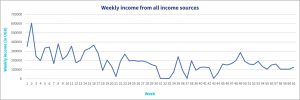
Image 1

Image 2
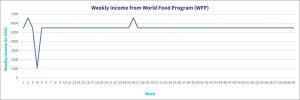
Image 3
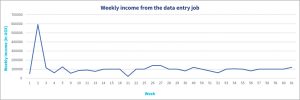
Image 4
We have analyzed the data from 2020 (Image 5) separately to understand if COVID-19 added more volatility to the income scenario. In the data from 2019, out of 19 weeks, we observed spikes in the income of six weeks and dips in the income of six weeks. This means that out of 19 weeks, six were spikes, six were dips, and only seven were “normal” or roughly the average. So, “normal” is the exception rather than the norm
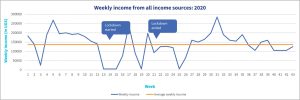
Image 5
In the data from 2020, out of 43 weeks, we observed 14 spikes and 10 dips, with a lower proportion of dips (23%) in 2020 compared to 2019 (32%). So, we cannot say that the shop suffered a loss in income during the lockdown and more broadly through the pandemic.
Now let us look at John’s business expenses. In an ideal situation, as the business is well established, the expenses should have been mostly stable. However, the data on expenses for the soft-drinks business shows a decreasing trend overall. As the pandemic progresses in 2020, for the first time (Image 6), we see consecutive weeks (weeks 31-34 and 40-44) without any business expenses. However, toward the end, we see a few weeks when business expenses, related mostly to the purchase of raw material, were comparatively high. Seeking to understand the reason behind this, we learned that the government implemented curfews and closed all borders to prevent the import of the disease. Hence, the imports of commodities were also stopped. This explains the consecutive weeks without any business expenses. Throughout these weeks, during and just after the lockdowns, John could not restock his shop. This led to limited supply and subsequently, a shortage of commodities in the market. Thus, some monopolists started hoarding commodities for future use.
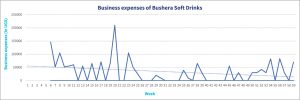
Image 6
This caused high demand, which led to high market prices. John eventually ran out of stock for his shop.
In this kind of situation, those with a savings reserve generally manage to survive, as money can buy stock even at higher prices. However, John had limited savings. He saves money in two ways—through a SACCO (Savings And Credit Cooperative Society), MOBAN (Moral Brotherhood and Neighborhood), and loans to others.
- In the data for 19 weeks in 2019, John’s total savings were 56% of his total income in 2019. Of his total savings in 2019, 65% was saved in the SACCO and 35% through lending.
- In the data for 43 weeks in 2020, John’s savings were just 22% of his total income—a significant drop from 2019. Of his total savings in 2020, 60% was saved in the SACCO and 40% through lending, which is roughly similar to that of 2019.
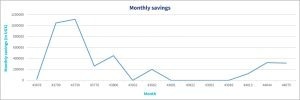
Image 7
The graph above (Image 7) highlights that John could not save at all for five months in 2020. As his income fell, John withdrew his savings from MOBAN (Image 8) and started saving more at home; however, his rate of saving reduced inevitably, with a greater temptation to spend the money on hand. John’s other savings tool, lending was also no longer feasible as creditors themselves struggled economically and started to default.
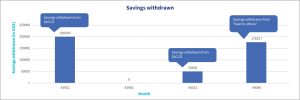
Image 8
John’s last hope to save his shop was to make a profit. He could use that money to support his household needs and buy more stock to sustain the shop. However, around May, 2020, the Government of Uganda asked fast-food businesses to not charge customers an inflated price to support the fight against the countrywide breakout of famine. This led to the fall of John’s business, who had finally sourced and bought a large consignment of stock for his business (see image 6 from week 44, that is, July, 2020) at relatively high prices.
John had hoped to make more profit, particularly due to the higher prevailing prices. When the government imposed lower prices, John could no longer sell his stock without making losses. He was forced to use the goods in the shop to feed his family and soon realized that he could not afford to run this business anymore.
Two factors forced John to close his business. Firstly, the decreasing profit from the business due to a shortage of stock in the market resulted in higher prices of stock. Secondly, the government’s directive that imposed lower sales prices. John diverted all the remaining reserves from his shop to a new venture of rearing livestock. And with that, Bushera Soft Drinks was no more.
What could have saved the shop from closing down?
John’s story demonstrates how precarious supply chains are, and how vulnerable small retail businesses are to price fluctuations, both in the prices of stock and the prices for sales.
Regulating the market price of commodities in times of emergency is critical to maintaining a healthy business ecosystem. However, the regulation must include both retailers and their suppliers to ensure that all parties maintain price. Secondly, all businesses–those who were operational and those who were not–needed support as the pandemic disrupted the buying patterns and reduced demand significantly. For others like John to survive, measures like direct cash transfers and credit guarantee for small businesses and loan moratoriums for longer periods could help.
We could unravel this rather complicated story with the help of detailed data from John’s financial diaries. This story and others in the Corner Shop project provide insights that can inform policy of the complexity and fragility of small retail firms in the poorest corners of the world.


Leave comments